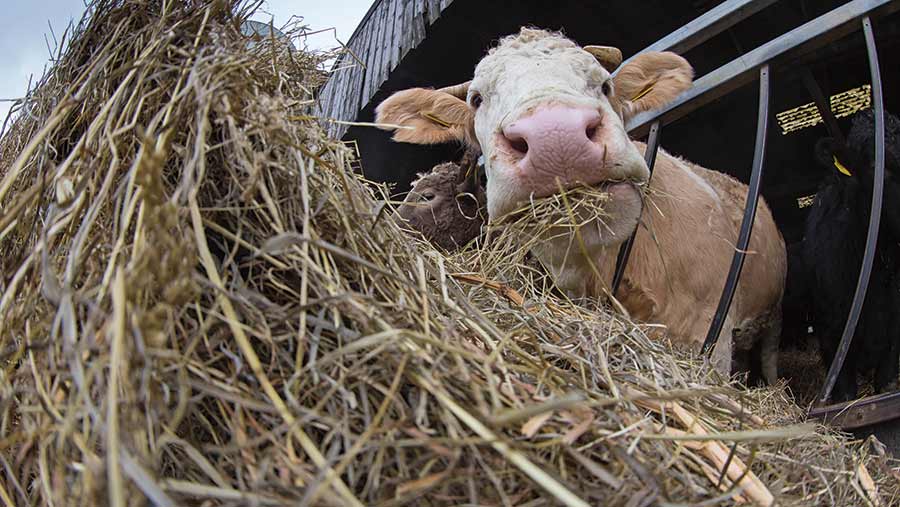Advice on feeding suckler cows at different stages of production
 © Tim Scrivener
© Tim Scrivener For suckler herds to remain profitable, it is essential that every cow produces a healthy calf every year within a tight calving pattern.
Nutrition has a huge influence on this, with a well-balanced diet likely to influence cow health and subsequently her fertility and calf output, as well as keeping production costs down.
Alex Corbishley, vet at Edinburgh University and Lachie Maclachan, nutritionist at Feedco, offer advice on feeding at various stages of the production cycle.
See also: Expert advice on creep feeding calves
Dry cow requirements
Perfecting the dry cow diet is critical for ensuring cattle are at the right body condition score at calving.
What to feed:
- Silage: relatively cheap but feeding ad-lib can lead to over-fat cows. Silage with an ME of 10.5MJ/kg should maintain condition.
- Haylage: if the cow is in good condition, average quality is sufficient.
- Straw: can help to manage over-fat cows.
- Additional protein: sources include grass, rape meal, brewers’ grains or lupins.
Body condition score:
Over-fat cows will face difficulties at calving due to a build-up of fat narrowing the birth canal, whereas thin cattle can lack strength for calving. This will lead to weak calves and poor-quality colostrum.
Example of a daily diet (based on a 650kg cow):
- 20kg silage and 4-5kg of straw
- 9.5kg straw (to appetite), 1kg of barley and 1.5kg rapeseed meal
- 9.5kg hay and 3kg of straw (to appetite).
Pre-calving (close up)
In the two to four weeks before calving, it’s important to keep the BCS stable, so this diet will be similar to the dry cow stage.
What to feed:
- High-quality forage: where forage is short, plan rations around calving dates – saving the best-quality forage until three weeks before calving.
- Magnesium: supplement in late gestation to reduce milk fever and slow calving.
Body condition score:
Body condition score at calving is linked to the calving interval. To keep as close to a 365-day pattern farmers should aim to calve down cows a BCS of 2.5.
Example of a daily diet (based on a 650kg cow):
- 1.3kg hay and kale
- 1.7kg rapemeal, 6kg straw, 4.5kg grass silage
- Ad-lib grass silage, provided intakes are high
- Supplement all diets with 100-150g/head of dry cow minerals (high in magnesium, low in calcium).
Post-calving to weaning
Freshly calved cows require around double the energy of a dry cow, so to keep a lid on feed costs, plan calving to coincide with the availability of cheap food.
What to feed:
- Grazed grass: particularly useful for spring-calving herds.
- High quality silage: helps maintain condition until service and sustain milk production.
- Concentrates: supplementary feeding will help if the cow is losing condition.
Body condition score:
A heifer’s BCS is likely to suffer significantly during her first lactation. To minimise this, early weaning can be useful for cows that are in poor condition in late lactation.
Example diets (based on a 650kg cow):
-
- Grazed grass
- 35-40kg of silage (based on 30% DM).
Pre-mating
To meet a 365-day calving interval, cows have around 80 days to recover from the previous calving to next conception, so nutrition needs to be optimised to ensure she is able to conceive. Any drop in body condition will likely compromise conception rates.
What to feed:
- Silage (10.5MJ/kg ME plus)
- Concentrates: an extra energy boost if needed to encourage the cow to cycle.
- Trace elements: selenium, iodine and vitamin E can improve fertility and calf viability.
Body condition score:
BCS at mating can have a major effect on the number of calves born.
As shown in a study by the MLC (Meat and Livestock Commission) in 1980, cows with a BCS below 2 weaned an average of 78 calves per 100 cows to the bull. In cows with a BCS of 2-2.5 this increased to 85 calves per 100 cows, while a BCS of 2.5-3 averaged 95 calves per 100 cows. Any cows with a BCS over 3.5 were prone to calving difficulties.
Fertility of cows calving at a BCS below 2.5 can be improved by high feeding levels immediately after birth.
Example diets (based on a 650kg cow):
- 35-45kg of silage supplemented with 1-2kg of cereals.
Effect of cow nutrition on colostrum quality
A study by vets at Edinburgh University looked at the correlation between cow nutrition and colostrum quality.
“Beef calves are born without any antibodies, and they rely on getting them through the dam in colostrum,” explains Rachel Bragg at the University. “After the first 24 hours, the gut begins to close to those antibodies, so it’s really important that high-quality colostrum is available straight away. If this doesn’t happen calves are at a higher risk of mortality and infections.”
The study involved completely milking out cows after calving to find out how much colostrum they produced and the antibodies it contained.
Cows were split into three groups: Silage-fed, straw-fed and silage-fed heifers. Cows fed on silage produced significantly more colostrum – with higher antibody levels – than either of the other groups.
|
Cow and feed group |
Colostrum produced (litres) |
Antibody levels within the colostrum (g) |
|
Cows fed silage |
4.5 |
862 |
|
Cows fed straw |
3.9 |
730 |
|
Heifers fed silage |
2.5 |
438 |
Case study

John Haimes
Farm facts
- West Sherford Farm, Devon
- 202ha – including 65ha arable.
- 100 cross-bred suckler cows
- Spring calving – rearing to 17-18 months and selling as stores.
- Buying in bulling heifers
John Haimes runs a 100-cow suckler herd in West Sherford, Devon. Having joined the AHDB’s Strategic Farm Network he began working with consultant Luppo Diepenbroek to try and get as much beef from grass as possible.
“One of our biggest changes was moving to a rotational grazing system,” he explains. Measuring the grass, he moves the cattle every three days and feeds grass silage in the winter.
Mr Haimes also sowed 40ha of herbal leys and 24ha of stubble turnips with forage rape. “We have put silage bales on the stubble turnips which will be strip grazed by 300-400kg youngstock – I hope to get around three months of grazing from that. The herbal leys will be grazed by 70 smaller weaned calves, which should feed them for around two months.”
Blood sampling carried out before calving showed there was a high health status across the herd, proving that the grass-based diet provided all the necessary requirements.
The farm also took part in the colostrum quality study, which showed that out of 15 calves sampled, only three were at marginal risk of failure of passive transfer – proving the benefit of a good-quality silage-based diet.
The effect of body condition score at calving on calving interval |
|
|
BCS at calving |
Calving interval |
|
1.0-1.5 |
418 days |
|
2.0 |
382 days |
|
2.5-3.0 |
364 days |
| Source: AHDB | |
Nutrient guidelines for a mature 650kg suckler cow |
|||
|
|
DMI (kg/day) |
ME MJ/day |
CP% in DM |
|
Early lactation |
12-14 |
120-130 |
11-12 |
|
Late lactation |
9-11 |
85-95 |
11 |
|
Dry |
10 |
75-80 |
9 |
| Source: AHDB | |||
